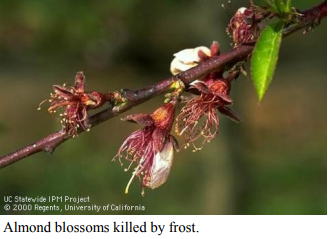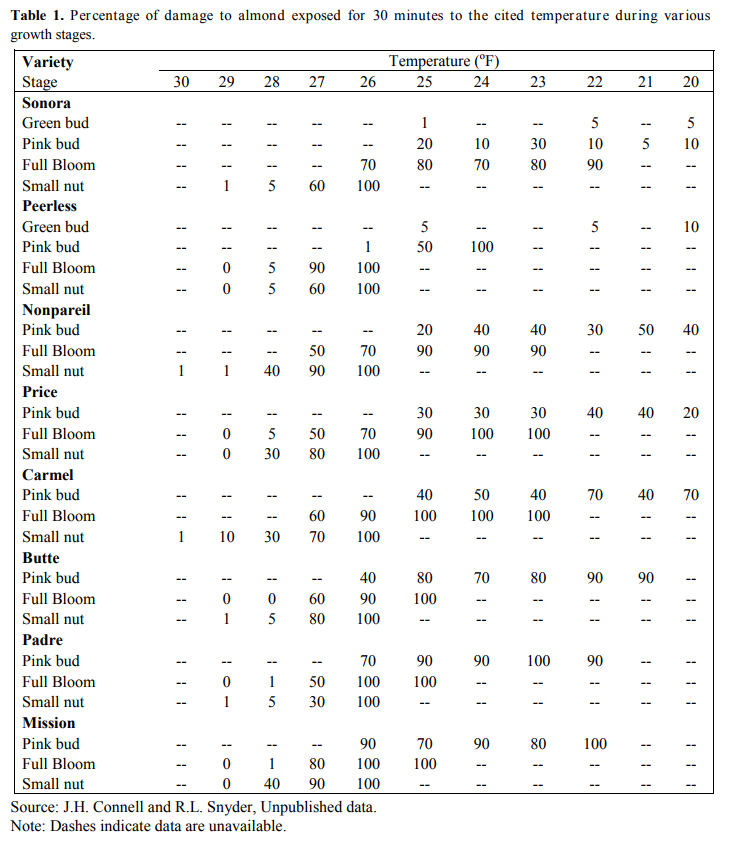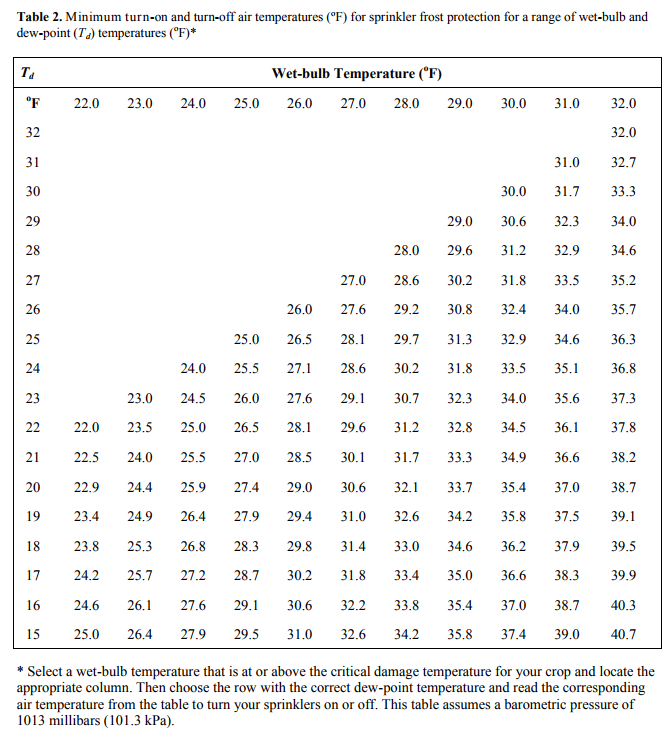
Via Orchard Facts UCCE Glenn County – January 2016
Joseph Connell, UCCE Farm Advisor Emeritus, Butte County
Richard Snyder, UCCE Biometeorologist, Land, Air and Water Resources, UC Davis
Mild, radiation frosts occur on still, clear nights, often with the development of a strong inversion. Under these conditions frost protection can be provided by running water. Advection frosts are more severe and usually result in more damage. They occur with wind present as cold air moves into a field from areas outside the orchard. Cold air is heavier than warm air, flows down slope like water, and accumulates in low spots or in areas where air drainage is blocked.
Frost Sensitivity
If water is used for frost protection, critical temperatures for frost damage help us know when to turn irrigation systems on or off. At pink bud, flowers are more resistant to cold compared to full bloom, which is more resistant than at petal fall or with small nuts. The following table provides an estimated percentage of cold injury to almond fruit buds and small nuts exposed for 30 minutes to cited temperatures at indicated growth stages.
Soil and Groundcover Condition
Groundcover condition affects orchard minimums with any cover taller than 4 inches in height generally being colder. Soil heat storage is reduced because sunlight is reflected and water is evaporated. Keeping groundcovers cut short to 2 inches or less during frost
season allows sunlight to reach the soil surface, and increases soil heat storage resulting in a warmer orchard through the night.
Bare soil with soil moisture near field capacity (about 2 days after wetting) is warmest because it transfers and stores heat best. If pre-frost conditions are dry and windy and a dry crust forms on the surface, then, bare soil can be colder than a surface with a short
(less than 2 inch) groundcover that tends to keep the surface moist with dew from the grasses and weeds. The ground surface must be moist but not saturated for bare ground to be warmest.
Dry or recently cultivated soil has many air spaces, lower heat storage capacity, and low heat conductivity resulting in colder minimum temperatures. Moist soil stores more heat due to water content, has higher conductivity, and will have higher minimum temperatures. Irrigation should ideally wet the top foot over the entire orchard surface, soil moisture should be near field capacity, and these conditions should be achieved in advance to gain the most advantage. A light irrigation to moisten dry soil a day or two before a frost will help obtain the greatest heat storage.
Sprinklers and Micro-sprinklers
Under tree sprinklers provide protection because freezing water releases sensible heat into the orchard system. If enough water is frozen, the surface temperature will not drop below freezing. This sensible heat is radiated or convected into the trees, thus providing protection. Solid set sprinklers applying 40 gallons of water per minute per acre will provide frost protection under most conditions we experience. A lower application rate will provide less protection and is more likely to fail in severe frost conditions. Sprinklers can be safely turned off when the wet bulb temperature upwind of the protected orchard is above the critical crop damage temperature or when all the ice melts. You can measure wet bulb temperature for your site using a psychrometer. Doing so can save water and pumping costs by turning off the system as soon as it is safe to do so.
In some orchards, frost protection is limited by the amount of water or movable pipe available. To learn more about moveable pipe placement we ran an experiment comparing protection with sprinkler lines in every middle, every other middle and every fourth
middle. Air temperature in all sprinkled areas was 1o to 2o F warmer than the unsprinkled control and there were no differences between these spacings. Soil surface temperatures were colder the further from the sprinklers, and the dry centers between the lines in
every fourth middle were as cold as the unsprinkled control. Line spacing directly affects soil surface temperature but air movement evens out the benefits. Without air movement, protection may fail between widely spaced lines.
In our experiments with micro-sprinklers, applying 15, 25, and 40 gallons per minute per acre resulted in little difference in observed air temperatures. However, exposed temperatures were 1o to 2o F warmer at the higher water rates. Exposed temperature is what
the buds themselves experience. The fact that the low water application gave a lower exposed temperature indicates that protection with under tree microsprinklers is coming mostly from direct radiation from the warmer wet spots under the trees rather than through convection of warmer air. We found a greater separation in exposed temperatures between the low and medium/high rates on the colder nights. Thus, micro-sprinkler application rate had little effect on air temperature but did affect temperature of exposed buds and flowers. The low application rate gave less protection than the higher rates and the higher soil surface temperatures from higher application rates led to more radiation heating. Under windy advective conditions this may be more important
since convection heating is negatively affected by wind but radiation is unaffected.
Drip irrigating in advance of a frost can help keep the orchard warmer by increasing soil heat storage particularly if the soil surface is dry. Running the system during a frost may provide slight benefits due to radiation heating from the wetted area beneath the trees. Flood irrigation for frost protection works in a similar fashion but due to larger water volumes it will provide more protection as long as ice doesn’t form on the water’s surface.


